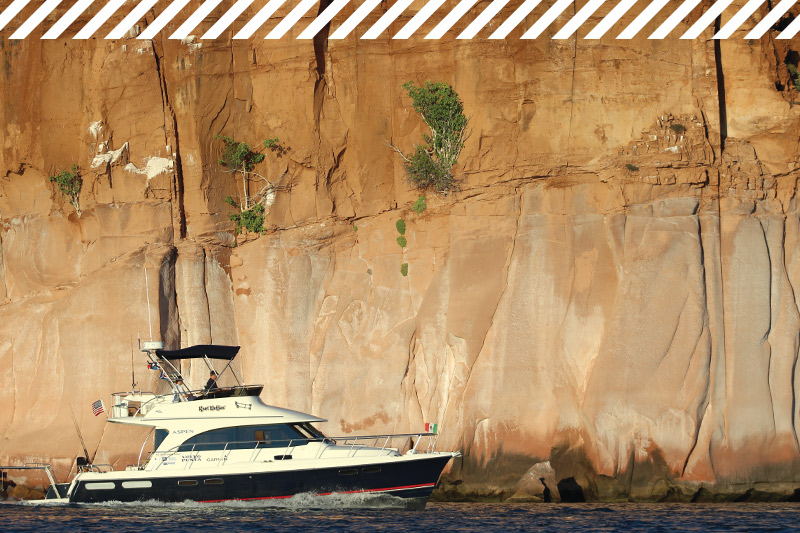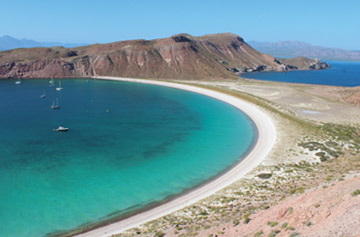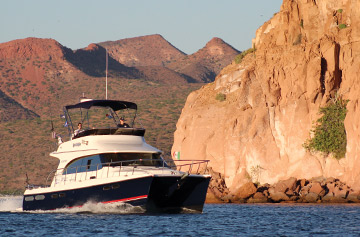
 I stand on the flybridge of Knot Wafflen’, where I look forward to an adventure with both familiar and exotic elements. The boat and I are well acquainted, but we are both on the unfamiliar waters of Bahia La Paz in the Gulf of California. The first time I was aboard was last spring in Anacortes, Washington, during a festive bon voyage affair under an overcast sky.
I stand on the flybridge of Knot Wafflen’, where I look forward to an adventure with both familiar and exotic elements. The boat and I are well acquainted, but we are both on the unfamiliar waters of Bahia La Paz in the Gulf of California. The first time I was aboard was last spring in Anacortes, Washington, during a festive bon voyage affair under an overcast sky.
The owners, David and Sue Ellen Jenkins, were launching their 10,000-mile tour to Annapolis, Maryland via Alaska, the West Coast, Baja California, an across Mexico overland trailer journey, the Gulf of Mexico, the Caribbean, and up the East Coast. Spirits were high, the new boater owners eager students on the cruising life learning curve.
The second time aboard Knot Wafflen’ was in SE Alaska where I got to really see what it was made of on the drizzly Tongass Narrows. Not only was it a great adventure in one of the world’s notable cruising grounds, but I was impressed with the C120’s performance in a variety of sea states and weather conditions.
Turns out, the boasts of designer and Aspen Power Catamaran co-owner Larry Graf were not idle. You can read more about that leg of the adventure in our August 2017 edition in the feature 10,000 Miles: Aspen Takes on Alaska (available at nwyachting.com).
The boat may be familiar, but the scenery is not. I’ve never been to Mexico, and the warm azure waters, red cliffs dotted with saguaro cactus, and expansive white-sand beaches are the exact opposite of the cold green waters, white-capped mountain backdrop, and pebble beaches of my native Puget Sound.
The same goes for Knot Wafflen’, which has spent most of its life in the North Pacific. Now it’s in air-conditioning country, not heater territory. Down here we need to worry about UV degradation, not moisture rot. How will it do? The boat is already pushing 7,000 nautical miles, thanks to the many cruising detours, and on a trajectory to easily surpass 10,000 miles by the time it reaches the finish line on the East Coast.

Like my time in Alaska, I’m aboard with Larry and Nick (Aspen salesman) Graf, a father-son duo. Larry’s favorite place is at the helm of the covered flybridge where he can take in the scenery. He usually has a cookie nearby to appease his sweet tooth. I’m chatting with him as we leave Marina CostaBaja behind in La Paz as this journey starts.
“Aspen (Power Catamarans) has become a real family affair!” Larry says of the company. Nick isn’t the only other Graf in the business, with his brother Steven and a few in-laws on board. For the Grafs, a boating family, the passion has become a career. In the cockpit, Nick inflates a giant pink flamingo float-toy that he picked up at the marina store for a handful of pesos. “El Flamingo” would be our unofficial mascot for the trip.
I look at Knot Wafflen’s performance stats on the Garmin display. We’re cruising at a conservative 6.5 knots after a detour to El Mogote, a peninsula near La Paz that’s known for visiting whale sharks and open public beaches. We got the tip from a local bartender in La Paz the night prior, but we do not luck out with a whale shark sighting. Our eyes turn to the islands in the Gulf and our living-off-the-hook ambitions.
Our speed of 6.5 knots is a typical one for a trawler or tug, some of the boating world’s favorite adventure cruising models. A typical trawler owner should be proud of a fuel efficiency of around two nautical miles per gallon. Knot Wafflen’ is pulling a remarkable six nautical miles per gallon on this calm day in Mexico, with a mild headwind of about five knots. We’re operating at an easy 1,350 rpm, and some simple math brings us to about 1.5 gallons per hour.
“The thing I really like about Aspens is that they can do both the trawler thing, with amazing fuel efficiency, but also perform very efficiently at higher speeds,” comments Larry, hinting at what’s to come. El Mogote fades behind as Isla Espíritu Santo comes into view. This 31-square-mile island is completely protected as part of the Area de Proteccion de Flora y Fauna – Islas del Golfo de California (APFF-IGC) and was declared a part of a UNESCO Biosphere Reserve in 1995. As we approach the southern tip of the island, fiery cliffs crowned with cactus rise to greet us, almost as if the Grand Canyon somehow dove into the Mediterranean Sea.
The sun sets and, after a somewhat harrowing photo shoot where I have my camera in one hand and the tiller of the dinghy’s 9.9-hp outboard in the other, we plan our final moves before dark. The plan was to put down the anchor for the night, but Larry eyes the increasing and shifting wind, from easterly to westerly. It’s forecasted to grow to 15 or more knots overnight, and the charts show less protection from the new westerly wind. He makes the call to jog back to Marina CostaBaja for the night. Once there, we scheme the next few days from the comfort of the slip with a few shots of congratulatory tequila for our first day boating in Mexico. ¡Salud!
We’re up early and underway the next day, a loose tequila-inspired scheme plotted out. Nick, an avid angler, is quick to drop a few lures, and we give trolling a brief shot. After not catching anything, we pull them in to get moving. The Aspen’s wide cockpit, while not specifically designed for angling, certainly has plenty of space and comes standard with a few rod holders. Perhaps future iterations will include more angler-centric features, like a live bait well or larger icebox for catch storage, but for now, the basics are covered.
Prime Cruising Territory
Golfo de California (the Gulf of California, also known as the Sea of Cortez) is a world-class cruising destination bordered by the Mexican states of Baja California Sur, Sonora, and Sinaloa. With over 5,000 species of macroinvertebrates, over 30 species of whales and dolphins (including the world’s smallest and most endangered porpoise, the vaquita, and the world’s largest animal, the blue whale), manta rays, Humboldt squid, leatherback sea turtles, coral reefs, and more marine life, the gulf is one of the most biodiverse locations on the planet.
Large sections of it are part of an official UNESCO World Heritage Site, and the Gulf is considered a true ecological gem. Baja California is the world’s second-longest peninsula and home to about two million people.

We ease past Puerto Balandra on the Baja Peninsula for a peak of El Hongo, an abnormal rock formation where a boulder is perched precariously on a narrow pillar of stone. It’s a brief detour to check another item off our Baja bucket list before we steer a course away from the mainland and take on the San Lorenzo Channel. We plan to drop anchor off La Playa Bonanza on Isla Espíritu Santo for lunch and to get in some quality beach time. While in transit, Knot Wafflen’s excellent tracking is on full display. Aspens, like many multihulls, naturally maintain straight courses with minimal management. In our case, Knot Wafflen’s tracking prowess is revealed by accident.
“Huh,” Larry says, amused. “I forgot to put it on autopilot. Oh well, I didn’t notice,” he laughs. I, the one distracting him, can attest that he didn’t even touch the wheel for the last two or so nautical miles, despite the 10-knot southwesterly breeze. I don’t know if I’ve ever been on another boat that tracks like that, and, true to its name, the boat is not waffling.
Once we arrive at La Playa Bonanza, we spend a few hours on the hook. The multi-mile stretch of white beach is completely deserted, and I snorkel the hard coral reef right offshore. The reef is crackling with activity, and curtains of bright tropical fish – from the beaked parrotfish to the schools of butterflyfish-part for my passing. Hours pass by all too quickly and it’s time to hop aboard. We have miles to go still.
We continue along the west side of Isla Espíritu Santo, past Punta Lobos (Wolf Point), Lago la Salina (Salt Lake), and Punta el Pailebote (Pilotboat Point). A stretch of sea caves scar up the cliffs, and volcanic layers of basalt cut across the rose-colored sandstone. The effect is a raw, prehistoric one, and I, for one, feel like we had drifted into a geology textbook. We push north past the tip of the island to Los Islotes, effectively a sea mount that overshot the water surface by a few hundred feet. Tabular rock formations are perfect lounging spaces for California sea lions of all ages, and the seabirds are so numerous that their droppings coated the monolith with a thick frosting.

Middle: An Un-Cruise ship under a fiery sunset.
Right: Isla Espíritu Santo’s geology on display.
With the wind coming out of the east at a brisk 12-17 knots, we opt to anchor at a popular sheltered spot, Ensenada Grande, on the west side. The bay is shared by a few fellow yachts, both sail and power. I inflate a kayak stowed aboard, a Walker Bay Airis model, and take it out for a spin in the bay followed by
a curious young sea lion who threatens to hop aboard. We again celebrate the sunset with a few rounds of tequila, and El Flamingo gets plenty of use.
After a quick breakfast and lashing El Flamingo to the flybridge, we buzz past an area called Los Cuevitas, which is rumored to be home to the iconic blue-footed boobies. I’ll admit, more than a few boobie jokes are exchanged that are beneath our readership. Sadly, the birds are absent, and we motor north again to give Los Islotes another shakedown. Conditions are rougher today, with a lively 14- to 16-knot southerly headwind and short 2- to 4-foot chop. Larry pushes Knot Wafflen’ a bit faster, and I look at the numbers.
Mile Journey
The 10,000-mile tour of Knot Wafflen’ is the epic adventure of owners David and Sue Ellen Jenkins. Sue Ellen’s brother, Captain Blake Eder, also comes along on the trips and maintains an active travel blog about the adventure
(bristolboatdelivery.blogspot.com/). David is an entrepreneur and found financial success with his waffle iron company, Golden Malted. The name Knot Wafflen’ is playful on many layers: the “knot” pun, the concept that they are out of the waffle business and having fun, the straight tracking capabilities of the Aspen C120, etc.

Knot Wafflen’ gets to a smooth 16.2 knots at 2,840 rpm, despite the 14-16 knot headwind and aggressive chop. A typical boat in this kind of situation would expect a fuel efficiency of around .5 nautical miles per gallon, give or take a few tenths. Lo and behold, we’re pulling in 1.2 nautical miles per gallon and using about 14 gallons per hour. The conversation with Larry the previous day comes to mind. Essentially, the Aspen C120 can be both a super-efficient 6 to 8-knot boat when needed, or a super-efficient sport cruiser at the 16- to 18-knot range.
What exactly is going on here? It’s worth digging into a few of the C120’s features to find out why it’s performing so efficiently. The design is a single screw, with the one engine sitting in the starboard hull. Therein lies part of the secret to the build’s fuel efficiency: less engine required.
Thanks to the efficient power proa multihull design, less engine effort is needed for the comparable performance to other boats. Lower power needs means a smaller, lighter engine to achieve that performance, which in turn reduces the overall weight of the vessel, and then increases the efficiency. There is a meritocratic cycle going on here that starts with the hull shape, reduces the drawbacks of a large cumbersome engine, and ends with top-notch fuel efficiency. Another feature that increases the efficiency are the dual trim tabs that Larry actively manages according to sea state to squeeze the most mileage out of a gallon.
Fuel efficiency provides another great ripple effect for a boater’s experience: adventure range with less fuel. The C120 comes with a standard 220-gallon fuel tank, and we can play with my Mexico numbers a bit to see roughly what to expect fuel consumption-wise. If we take the trawler-like performance numbers (about 6 knots) in ideal conditions from the previous day and compare them to the more demanding sport cruiser performance into a decent headwind and chop of this day, we’ve got a pretty good range of typical data to examine.
Knot Wafflen’, outfitted for cruising with four passengers aboard, has demonstrated a fuel consumption range of 6 nautical miles per gallon to 1.2 nautical miles per gallon, meaning a total travel range of around 1,320 nautical miles (conservative cruising in calm waters) to around 260 nautical miles (fast cruising into rough headwind). Not only is this comparable to larger, bulkier, more fuel-guzzling trawlers, but Knot Wafflen’ is using a fraction of the total fuel, saving dollars at the pump and carbon in our atmosphere. I eagerly keep an eye on our stats, curious as to how far we’ll travel and how much fuel we’ll eat up on this trip.
The rest of the day passes as a sort of sun-drenched daydream. I manage a quick dip at Los Islotes. Schools of rays and fish ripple the water around me. Our visit is brief, and (while I don’t see any), manta rays, great hammerhead sharks, and whales are supposed to be common. The day stays blustery as we make headway to Isla San Francisco for exploration and a night on the hook in Bahia San Francisco. Notable about the Aspen C120 is the comfort of the ride. There is some kind of voodoo going on with the hull, which Larry chalks up to purposeful design elements.
“The power proa hull is asymmetrical and the tunnel design is unique,” says Larry. “The inner chine grows quite a bit. If you are going into a head sea and you want to bob, there’s quite a bit of lift there because the inner chine is about three times the size of the outer chine, which allows the boat to lift very well.” There are also some features in the top of the tunnel as the vertical wall rolls into it.

Middle: Knot Wafflen’ with Isla San Jose background.
Right: Aspen Power Catamarans father-son duo, Larry (right) and Nick (left)
Graf on a beach in La Paz before the adventure begins.
“There is a step there that breaks off the water and creates a bubble water zone that helps with the cushioning at different speeds. There’s also a large asymmetrical wave breaker down the center of the tunnel that helps a bit in a tight chop. The wavebreaker also stiffens up the hull and gives us a wonderful place to run wires and cables to the dash.”
Additionally, the tunnel height to tunnel width ratio is quite steep at 5:1. While many catamaran designs go wider to maximize interior space, going too wide invites wave slap. While the Aspen’s higher tunnel design is not impervious to that slapping feeling, the performance in the day’s breeze and chop is quite smooth compared to what the average monohull would be like. The boat definitely likes to bob more than slap as we carve our way onward.
All good things come to pass, I suppose. We drop the hook midday at Isla San Francisco and spend the day ashore, in the water swimming, and generally enjoying the cruising lifestyle. I am tagged by a few jellies while in the water, but the stings only add to the I’m cruising Mexico! feeling. El Flamingo makes another celebrity appearance. We motor around in the dinghy at sunset and run into a friendly cruising couple aboard a Nordhavn. David and Carrol hail from Juneau, Alaska, where David used to work as a tugboat captain. Content with their adopted golden retriever and sunset drinks in hand, they certainly seemed like a poster couple for “Living the Dream.”
We awake after our final morning on the hook and make the most of the day. We cruise past Isla Coyote, essentially a rock with a fishing town of around 20 people, fewer than 10 houses, several docked fishing pangas, and a church.
 Mexico is mostly known for its tequila and light beach beers (think Corona and El Modelo), but we stumbled upon the colorful tallboys of Barrios De Los Muertos (Neighborhoods of the Dead) from Monterey, Mexico-based Cervecería Cuauhtémoc Moctezuma S.A. de C.V. (a Heineken subsidiary).
Mexico is mostly known for its tequila and light beach beers (think Corona and El Modelo), but we stumbled upon the colorful tallboys of Barrios De Los Muertos (Neighborhoods of the Dead) from Monterey, Mexico-based Cervecería Cuauhtémoc Moctezuma S.A. de C.V. (a Heineken subsidiary).
A milk stout, this dark ale has a hint of caramel and nice copper color. It’s 4.1% Alcohol by volume (ABV) and, while light by milk stout standards, is on the heavier side of Mexican beers.
Knot Wafflen’ continues to the mangroves of Bahia Amortajada on Isla San Jose, and I poke around on the dinghy and the Walker Bay Airis inflatable kayak. I’ve never seen saguaro cactus and mangroves in the same place before, and the place is alive with turkey vultures, pufferfish, bees, and schools of mullet. I slap on my mask and snorkel for a last coral reef tribute before we lift the anchor for the last time and make swift headway back to Marina CostaBaja in La Paz. El Flamingo is deflated for good.
Being the boat nerd that I am, I look at our performance numbers. The conditions today are different yet again, and now we have about 8 to 10 knots of wind at our backs with about one-foot waves. For many boats, especially multihulls, quartering following seas are a nightmare. However, at 17 knots at 2,870 rpm, we’re surfing. We sip fuel at 1.2 nautical miles per gallon for around 14 gallons per hour.
We pull into our slip and divvy out clean-up chores. We want to leave Knot Wafflen’ in great shape for Jenkinses, who are planning to hop aboard again sometime in the coming days.
As Larry and I prepare to search for propane (quite an endeavor in La Paz) and the others spearhead the deck swabbing, I look at the final numbers. All in all, we boated non-stop for four full days and traveled more than 120 nautical miles. Our total fuel consumption? About 60 gallons, or about a quarter of the tank. The whole trip flashes before my eyes, all made possible by the modest consumption of 60 gallons of diesel.